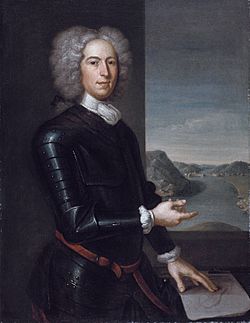Siege of Annapolis Royal (1745) facts for kids
Quick facts for kids Siege of Annapolis Royal (1745) |
|||||||
|---|---|---|---|---|---|---|---|
| Part of King George's War | |||||||
 Nova Scotia Lt. Gov. Paul Mascarene, commander of the 40th Regiment, portrait by John Smibert, 1729 |
|||||||
|
|||||||
| Belligerents | |||||||
Mi'kmaq Indians Maliseet Indians |
|||||||
| Commanders and leaders | |||||||
| Paul Mascarene Edward Tyng |
Paul Marin de la Malgue Antoine Le Poupet de La Boularderie |
||||||
| Strength | |||||||
| 250? | 500 French soldiers and natives | ||||||
The Siege of Annapolis Royal in 1745 was a battle where French forces, along with their Acadian and Native allies, tried to take back Annapolis Royal. This town was the capital of Nova Scotia (also known as Acadia) and was controlled by the British. It happened during a big war called King George's War. This was the third time the French and their allies tried to capture Annapolis Royal.
During the siege, a person named William Pote was captured. He later wrote an important story about his time as a prisoner. These kinds of stories, called captivity narratives, are rare from this area.
Why the Siege Happened
The British took control of Acadia when they captured Port Royal in 1710. The British then renamed the town Annapolis Royal. In 1713, the Treaty of Utrecht officially gave Acadia to Britain.
However, there were disagreements about the exact borders of the land. Also, some Acadians did not want to be ruled by the British.
During King George's War, the French decided to try and take back Nova Scotia. At that time, the British only had two main outposts in the colony: Canso and Annapolis Royal. The French, led by an officer named Devier, quickly defeated Canso. After that, they tried to attack Annapolis Royal, but they were not successful. The French tried to capture the capital again the next year.
The 1745 Siege
Just a few days after New England forces began to attack Louisbourg, a French officer named Paul Marin de la Malgue led about 200 French troops. He also had hundreds of Mi'kmaq warriors with him. They started a three-week siege against the British at Annapolis Royal. This French force was much larger than the one that attacked Annapolis Royal the year before.
During the siege, the English soldiers destroyed their own officers' fences, houses, and other buildings. They did this to prevent the attackers from using them for cover or as places to hide. Marin's forces managed to capture two small ships and took one prisoner.
The siege ended when Marin was called away to help defend the French during the Siege of Louisbourg (1745). Also, a British naval officer named Edward Tyng arrived, which helped to break the siege.
What Happened Next
During the siege, the Mi'kmaq and Maliseet warriors captured William Pote and some of Gorham's Rangers. John Gorham himself was not there because he was fighting at the Siege of Louisbourg with his father.
While he was a prisoner, William Pote wrote one of the most important stories about being captured in Acadia and Nova Scotia. He described his difficult experiences. For example, while he was held in a place called Cobequid, Pote heard an Acadian say that the French soldiers should have "left their [the English] carcasses behind and brought their skins."
Later, Pote was taken to the Maliseet village of Aukpaque on the Saint John River. On July 6, 1745, Mi'kmaq from Nova Scotia arrived there. They treated Pote and a Mohawk ranger named Jacob very harshly. This was done as revenge because Ranger John Gorham had killed some of their family members during the Siege of Annapolis Royal (1744). A few days later, on July 10, Pote saw another act of revenge when the Mi'kmaq treated another Mohawk ranger harshly at Meductic.
Marin was not able to help Louisbourg because the New Englanders stopped him in a naval battle near Tatamagouche.
The area of Grand Pre had been used by the French and Mi'kmaq as a starting point for their attacks on Annapolis Royal. Because of this, John Gorham wanted to take control of Grand Pre after both the 1744 and 1745 sieges.
The French made one last major attempt to regain Annapolis Royal with the Duc d’Anville Expedition.
Images for kids




